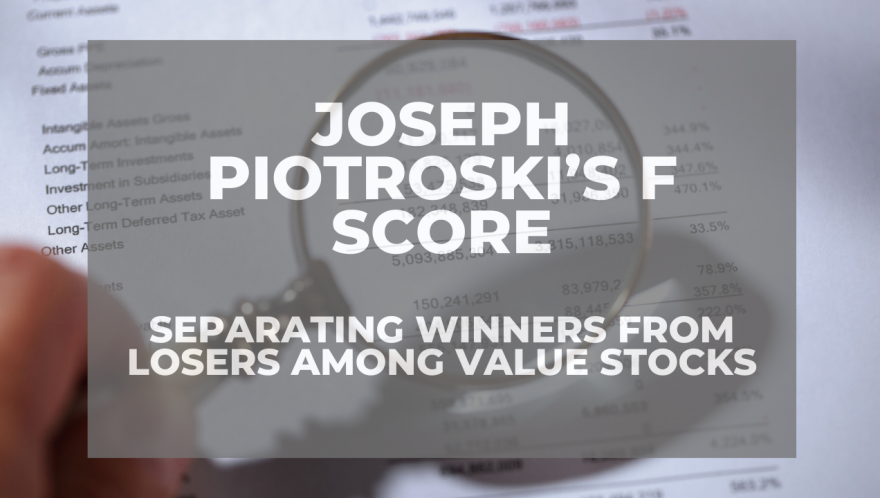Joseph Piotroski, a professor of accounting at the University of Chicago, published a groundbreaking research paper in 2000 titled “Value Investing: The Use of Historical Financial Statement Information to Separate Winners from Losers”. In the study, Piotroski laid out a compelling case for using financial statement analysis to separate winners from losers among the cheapest stocks. His findings form the basis of the Validea Book/Market Investor model.
Piotroski’s Research: Finding Bargain Stocks Ready to Rebound
Piotroski’s key insight was that by focusing on stocks with high book-to-market ratios (i.e. value stocks) and applying a series of financial health checks, you could identify the true bargains most likely to deliver excess returns. Many value stocks are trading at a discount because they are financially weak and unlikely to turn around. But some are unfairly overlooked by the market despite having robust financials. These are the hidden gems that Piotroski sought to uncover.
Through a battery of nine accounting-based tests, Piotroski assigned each value stock an “F-Score” between 0-9, with higher scores indicating better financial fitness. When he applied this technique to historical market data, the results were remarkable. A portfolio of high book-to-market stocks scoring 8 or 9 on Piotroski’s F-Score scale outperformed the market by 7.5% annually. Conversely, those scoring 0 or 1 lagged the market by 8.3% per year on average.
Inside Piotroski’s F-Score
So what exactly goes into computing the F-Score that powers Piotroski’s market-beating strategy? The score aggregates nine individual tests of a firm’s financial well-being, including:
- Positive net income
- Positive return on assets in the current year
- Positive operating cash flow in the current year
- Operating cash flow exceeds net income
- Lower ratio of long term debt to assets versus previous year
- Higher current ratio versus previous year
- No net new shares issued in the last year
- Higher gross margin versus previous year
- Higher asset turnover ratio versus previous year
One point is awarded for each test a stock passes, resulting in a final F-Score between 0-9. The higher the score, the more financially sound the company. Piotroski found that value stocks with scores of 8 or 9 consistently delivered market-beating returns, while those scoring 2 or below tended to substantially underperform.
5 Stocks Scoring Highly on Validea’s Piotroski Model
Validea’s Piotroski-based model uses the criteria from the paper to filter through 3000+ stocks every day to find the highest scores. Our model starts with the 20% of stocks with the lowest Price/Book ratios in the market and then applies the 9 F Score criteria.
Here are 5 stocks currently earning high marks from this approach:
G-III Apparel Group (GIII): G-III Apparel designs, sources, and markets apparel and accessories under owned, licensed and private label brands. It scores an 8 out of 9 on Validea’s Piotroski model, passing every test except for improved asset turnover. Highlights include surging return on assets, robust cash flows exceeding net income, reduced long-term debt, and expanding margins.
The Manitowoc Company (MTW): Manitowoc is a leading global manufacturer of cranes and lifting solutions. It earns a perfect 9 out of 9 F-Score from Validea’s Piotroski model based on its pristine financial condition. The company delivered positive net income and return on assets, strong free cash flows, and improving liquidity and operating efficiency in the most recent year.
United States Cellular (USM): U.S. Cellular provides wireless services to around 5 million customers across 21 states. It passes 8 out of the 9 Piotroski tests tracked by Validea, only falling short on asset turnover improvement. USM’s strengths include positive net income and return on assets, substantial operating cash flow, reduced leverage, and improving margins.
Kohl’s Corporation (KSS): Kohl’s operates as an omnichannel retailer, offering branded apparel, footwear, and accessories through over 1,100 stores and online. It receives an 8 out of 9 score from Validea’s Piotroski screen, thanks to its positive profits, strengthening return on assets, healthy cash flow, increased liquidity, stable shares outstanding, and expanding gross margin.
Oil States International (OIS): Oil States provides specialty products and services to oil and gas companies worldwide. Its F-Score from Validea’s Piotroski model comes in at a solid 8 out of 9, driven by positive net income, substantially higher return on assets, strong free cash flow generation, improved liquidity, reduced share count, and rising asset turnover. The only metric holding it back from a perfect score is flat gross margin year-over-year.
Joseph Piotroski’s landmark research shed new light on how to use financial statement analysis to separate the best value stocks from those likely to continue lagging the market. By applying his F-Score methodology, Piotroski demonstrated that investors can avoid value traps and achieve market-beating returns from a diversified portfolio of financially fit firms.
Further Research









